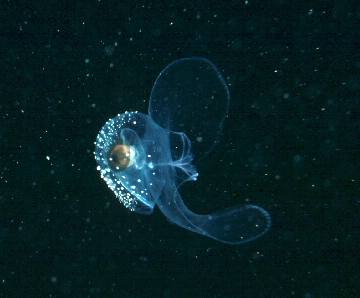Rising carbon dioxide levels could devastate marine food chain
Rhett A. Butler, mongabay.com
September 29, 2005
Rising carbon dioxide in the atmosphere could make oceans too acidic for marine organisms to produce protective shells according to research published in the journal Nature. Such a development could be catastrophic for the ocean’s food chain and devastating for world fisheries.
An international team lead by Jim Orr of the Laboratory for Science of the Climate and Environment in Gif-sur-Yvette, France, used computers to model the impact of increasing carbon dioxide levels and the acidity of oceans. Their projections show that by 2100, the amount of carbonate available for marine organisms could drop by 60%. In surface ocean waters, there may be too little carbonate for organisms to form shells as soon as 2050. The regions most affected would be the Southern Ocean around Antarctic and the subarctic Pacific Ocean.
The loss of these small organisms would have a disastrous impact on predators — including salmon, mackerel, herring, cod — that rely on them as a food source and could spell trouble for other species.
The concerns over increasing acidity of the world’s oceans extends to other parts of the world as well. In July, a report by the Royal Society, said that rising carbon levels will make if harder for sea creatures like coral, shell fish and star fish to form shells and skeletons. Further, higher levels of carbon dioxide and warmer seas will reduce the amount of oxygen available to ocean life. Another study, released in the September issue of Geology, suggests that dramatically warmer ocean temperatures may have contributed to the worst mass extinction on record. During the Permian extinction, which occurred some 250 million years ago, about 95% of ocean’s life forms became extinct.
 The pteropod or sea butterfly is one marine organism that could suffer in more acidic seas. A recent experiment by Victoria Fabry at California State University San Marcos found that the shells of pteropods, when subjected to conditions as projected by the model for the year 2100, rapidly dissolved. Photo courtesy of USGS. |
Atmospheric carbon dioxide — which can result from the combustion of fossil fuels — has increased from pre-industrial levels of around 280 parts per million to 380 parts per million today. About 35% of these carbon dioxide emissions are absorbed by oceans, which can cause problems for marine organisms. As it is absorbed into the ocean, carbon dioxide “strips out carbonate ions dissolved in surface waters, so there is less available for marine organisms to build calcium carbonate shells and exoskeletons” writes Ian Sample, science correspondent for The Guardian, in a September 29, 2005 article. Calcium carbonate is also the main constituent of coral reefs.
This article is used information from The Guardian, Nature and the Royal Society.
Rising acidity levels changing life in Southern Ocean
Press release from CSIRO
Steadily increasing levels of seawater acidity could re-shape strategic food chains in the polar and sub-Antarctic marine ecosystems earlier than predicted, according to research published today in Nature.
“Within 50 to 100 years, there could be severe consequences for marine calcifying organisms, which build their external skeletal material out of calcium carbonate, the basic building block of limestone,” says Australian scientist, Dr Richard Matear.
“Because these organisms provide essential food and habitat to others, their demise could affect entire ocean ecosystems,” he says.
Dr Matear from CSIRO’s Wealth from Oceans Flagship and the Antarctic Climate and Ecosystem Cooperative Research Centre says species most threatened are cold-water calcifying organisms, including sea urchins, cold-water corals, coralline algae, and plankton known as pteropods—winged snails that drift through surface waters.
Rising levels of carbon dioxide, considered the primary source of greenhouse warming, promote acidity and affect the concentration of calcium carbonate. As well as being published this week in Nature, the new research will be discussed at Greenhouse 2005, an international conference in Melbourne from November 14-17.
Hobart-based Dr Matear is one of 27 marine scientists who authored the report, the first cold region study showing how increasing levels of carbon dioxide may shape life in the polar, Arctic and Antarctic and sub-Antarctic oceans.
Scientists included a decade of ocean measurements obtained during Southern Ocean and sub-Antarctic voyages south of Australia by Antarctic re-supply vessels such as Aurora Australis to develop their simulations of this impact of climate change.
The Southern Ocean is recognised as a ‘sink’ – where more carbon dioxide is absorbed into the ocean than anywhere else. The oceans absorb about one third of carbon dioxide, and since about 1800, nearly 50 per cent of this has been absorbed in the Southern Ocean.
The process of carbon dioxide uptake or absorption at the ocean surface occurs most effectively in high wind and storm conditions, especially in regions between 45S and 65S. The carbon dioxide is carried by currents and eddies into the interior of the ocean and stored away for hundreds or thousands of years. Until now, recent predictions of future change in surface ocean conditions have been averaged across the globe or specifically in tropical oceans where reef-building corals are abundant.
The research involved science institutions in the US, Europe, Japan and Australia. In Australia, the research undertaken by the Antarctic Climate and Ecosystem CRC and CSIRO Wealth from Oceans National Research Flagship was undertaken with the assistance of the Australian Greenhouse Office.